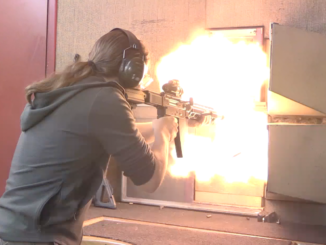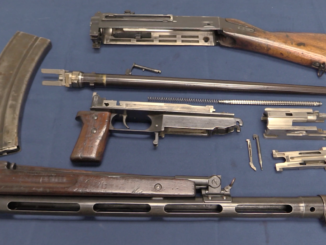During World War II, the Swiss military experimented with two models of K31 carbine with integral optics (the K31/42 and K31/43). These were found to be not sufficient for military service, and after more experimentation and development, the ZfK-55 rifle was adopted in 1955. What we are looking at today are a pair of transitional guns from the developmental period between the two.
These two rifles came out of the SIG museum, and show a number of features with both the K31/43 and the ZfK-55. For instance, they use a prismatic scope like the K31/43, with the same type of range adjustment. However, the front end of the scope is fixed in place, where on the 43 model it could fold down for protected storage. Additionally, the scopes on these rifles are detachable, like the ZfK-55.
Unfortunately, I have no information as to the exact dates of these two transitional models, nor details on their trial and evaluation.




What a nifty way to adjust the scope by replicating the same type of range measurements on a leaf like the iron sights…
Do side mounted scopes offer any disadvantages over scopes mounted on top of the receiver? Why is it that side mounted scopes have basically completely disappeared?
There is a slight disadvantage in offset scopes. The scope must be zeroed in such a manner that traditional crosshairs must be tilted slightly off center. This means that the lenses must be ground to match or adjusted angularly to account for the fact that it is above the bore axis and to the side of the bore axis at the same time! The best offset scope I can think of would the that of the Type 97 Sniper Rifle (assuming the serial numbers of the rifle and scope match up).
Originally the side mounted scopes were made to allow bolt-action rifles to feed from stripper clips. A scope placed directly over the magazine area would prevent quick reloading. Therefore, there were two options: feed your rifle one cartridge at a time (long process) or have somewhat quirky optics with a fast reload and the option to use iron sights if your optics fail. The Swiss got around this by rotating the action and magazine of the rifle 15 degrees clockwise (relative to the user), thus allowing a scope on top close to your eyes and a rapid reload function. When sniper rifles and designated-marksman’s rifles began feeding from detachable magazines, the side-mounted scopes disappeared!
Having a scope to the side does complicate getting the alignment of the mounts correct.
The castings for the British WWII and later sniper rifle mounts were actually line bored when they were fixed to the receive, to ensure correct alignment
they were located exactly above and parallell to the bore in the horizontal plane
I’m not sure whether there was several minutes of convergence with the bore in the vertical plane
about 4 to 6 minutes of angle would be usual, depending on the height of the scope axis above the bore axis, so that the bullet’s first crossing of the line of sight is at about 25 yards with the scope adjustments in the centre of their range of travel
This is almost a classic case of due technical compromise. The rifle, being true and tried, certainly one of the best had unfortunate direction of ejection. So, what to do? the only way was to fiddle with sight and it ended in this weird (should I say more respectfully “unorthodox”) creation.
Again, what strikes the most is visible quality of al parts.
“The rifle, being true and tried, certainly one of the best had unfortunate direction of ejection.”
This reminded about Winchester Model 1894 – http://guncollectionsonline.com/winchestermodel94.htm – or to be more precise Winchester Model 1894 ANGLE EJECT.
Earlier version ejected spent cases upward thus complicating mating this model of rifle with scope, thus ejecting trajectory was changed.
What an interesting article — thanks very much to Ian and to all who have contributed such insightful observations. I currently have two standard K31’s in excellent condition, and they are superbly accurate as-is, especially when using Mil-Spec Swiss RUAG GP11 or Prvi Partizan 174 grain FMJ-BT ammunition. I have been gradually learning a bit more about the sniper-type variants / descendants of the K31 and the many small but significant nuances involved, and this article has added even more fascinating detail to the general knowledge base.
I realize that there were several scopes with prismatic bends put in them
and I realise that the Swiss had access to some of the best precision machinists and machines ever
but it seems to be either folly or hubris to put a prism and a wobbly (and probably leaky, rotating joint [b] IN FRONT[/b] of the reticle. any rotating joint requires an clearence, and it will wobble
Lenses are difficult enough to mount, by definition lenses have curved (and usually spherical at that) surfaces rather than nice flat surfaces to sit flat, and they don’t all have long cylindrical side surfaces to guide them in mounting. you’d normally look for a cylinder surface equal in length to diameter for good guiding, and extremely few lenses have that.
A lathe can create circular and flat surfaces that are nicely at right angles or near enough, and a single piece tube – at least from the front glass element back to the reticle would minimise any potential for mis alignment.
but a prism, is both heavy, so lots of inertia during recoil and handling, and it difficult to mount accurately.
behind the reticle, misalignment is vastly less important, so long as the image is the right way up and can be clearly seen, it is ok, so putting a prism and a kink behind the reticle wouldn’t be so difficult or offer so much potential to screw up accuracy
The Swiss really were making life hard for themselves.
“The Swiss really were making life hard for themselves”
I have impression that Swiss arms producers believe in rule: if you ask about price that mean you are poor. For me best example of this is W+F Lmg.-Pist 41/44 Furrer submachine gun:
http://world.guns.ru/smg/switch/w-f-lmg-pist-41-44-e.html
As numbers suggest it was first adopted in 1941 and later improved in 1944. Rather than using blow-back principle as most 1940s 9×19 sub-machine gun it use peculiar principle of operation (see link) which require tight tolerances and thus make weapon expensive. Finally it was replaced by license version of SUOMI sub-machine gun which was cheaper (notice that SUOMI itself was not cheap weapon when compared to other 1940s sub-machine guns).
Other good example is Mg 51:
https://en.wikipedia.org/wiki/MG_51
It was based on German MG 42, however process of stamping was widely changed to machining – this is inverse of 1950s world trend in which machining was more desired that machining.
For the MG42 clone, it may well be that for the numbers that the Swiss forces were anticipating, that it was cheaper to go with the machines that they had, than it was to tool up to make the pressings
A bunch of nice Swiss milling machines would probably be easier to move underground – if that was ever needed, than moving a set of presses and dies for pressing underground.
but that again ignores the question of why the Swiss didn’t spend a little of their gold on buying up fifty or a hundred years worth of MG42s and spares from the victorious powers, who by that time were all getting a bit short of gold.
That was one of the junctures in history when gold would have bought them lead and brass.
Perhaps the perfectionist Swiss didn’t trust German workmanship?
or perhaps they wanted their labour to ascend to heaven as prayers?
you’re onto something there!
Calvin (religious “reformer”) spent time in Zurich, and his creed took hold and persisted in switzerland (as well as in the Netherlands and Scotland, Cromwell pretty much sickened England with a big binge and overdose of Calvinism and the French calvinists (Huguenots) ended up being purged and leaving France).
To Calvinists such as Adam Smith (and carried on by his intellectual rather than religious followers such as David Ricardo and Karl Marx) the value of a thing came, not from the subjective value of the uses it could be put to, but from the objective labour pain in its production…
Labour wasn’t only a curse following from original sin, it was a virtue and a way of praising their god.
Success in labour was an indication that a person was ammongst the “elect” few who were to be spared by (their) god from the total and universal damnation of humanity to hell.
There was an article years ago (late 80s or early 90s) in a gun digest, about Swiss martini actioned target rifles made by companies like Hammerli. It said that they were typically finished in bright polished steel, as bluing would imply that the owner was too lazy to keep it properly cleaned oiled and rust free.
In the joke about European hell, The food is English, the organization is Italian, the cops are French and the lovers are Swiss
I’d read Ian’s series of posts on Furrer
What I hadn’t realised until your link, was that the Furrer SMG had the mag on the right to snag on obstructions and ejected infront of the firer’s face, perhaps not too bad with the Furrer’s locked breech, but still…
It’s clearly a left hander’s gun!